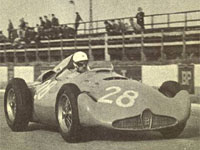Colombo's flawed brilliance
Author
- Mattijs Diepraam
Date
- 8W October 1998 issue
Related articles
- Alfa Romeo 158 - The voiturette that became the Grand Prix car to beat, by Mattijs Diepraam/Felix Muelas
- Bois de Boulogne - The cradle of motorsport, by Rémi Paolozzi
Who?Maurice Trintignant What?Bugatti T251 Where?Reims When?1956 French GP |
 |
Why?
In one sense the Andrea De Cesaris of his time, Maurice Trintigant drove a greater variety of F1 cars than most of his contemporaries. Also, when he finally retired from F1 at the age of 47, he had driven in 82 Grands Prix, an amazing number at the time, to be well compared with Andrea's massive amount of 208 participations. But very much unlike De Cesaris he actually managed to win a few of them (amongst which two famous Monaco wins) and in the process crashed a lot less cars! In fact, he was loved by team managers because of his gentle style keeping the material in one piece.
Trintignant was the youngest of five brothers of which three went racing as well. He was steadily becoming an established figure in Grand Prix racing in the late thirties - winning the 1939 Grand Prix des Frontières at Chimay - when his career was interrupted by the outbreak of World War II. Straight after the war Maurice went back to racing again, entering his late brother's Bugatti in the famous Bois de Boulogne Grand Prix near Paris, a race that was won by the legendary Jean-Pierre Wimille. Le Petoulet ('rat dropping') got his nickname after it was discovered that he retired due to his fuel tank being filled with the above-mentioned stuff...
Trintignant accepted the nickname in good humour and moved on to become a respected member of the new F1 era. In the pre-Championship days he shone in national racing for Gordini before surviving a coma suffered from a horrendous crash at the fiersome Swiss Bremgarten track. Although he was pronounced dead at one time he fought back to regain his strength and was winning races again by 1949.
Always in for a challenge, Trintignant took on various odd-jobs, driving all sorts of works and private cars in a World Championship career which lasted an amazing 15 years. Amongst the outlandish material Trintignant drove in Championship races were a De Tomaso, an Aston Martin and a Bugatti, three famous names from motor racing history which in the end only featured in the margins of post-war F1.
Bugatti's sole Championship appearance came at the 1956 French GP at Reims and Trintignant - one of Bugatti's pre-war stars - was released by Vanwall and drafted in to drive the technically advanced Type 251, the first French mid-engined design. The cars (the number 28 and its spare) took a lot of interest in the paddock - try spotting famous motor racing journalist Denis Jenkinson in this picture!
In sporting terms, however, the car was definitely not a success, Maurice qualifying 18th (on a 20-car grid) and retiring with a broken throttle pedal. The car featured a straight 8-cylinder engine laid out transversely across a flat chassis with the fuel tanks mounted in the bulky sidepods, a concept embarked on only later in the sixties at Honda.
The designer of the T251 was none other than Gioacchino Colombo, the man behind the Alfetta and the first 'real' post-war F1 car, who eventually went on to mastermind the MV Agusta 500cc effort in the seventies. The plans to build on this showing with a whole squadron of T251s fell through, however, and Bugatti never featured in GP racing again.
Reader's Why by Eugene Zhmarin
The great French builder of racing and high-perfomance cars never managed to get back into production after the war - although a handful of cars were built. Following Ettore Bugatti's death, the destiny of the company was guided by his younger son Roland and with former chief mechanic Pierre Marco acting as his mentor. They were keen to build a new competition car and schemed a basic design that could run in both Formula 1 and sports car racing.
Giaocchino Colombo (Alfa Romeo 158, the first post-war V12 Ferrari) was commissioned to design the new car. The design was unconventional by any standard, for it featured a straight-eight engine mounted transversely at the rear of the chassis. It was supposed to develop 275 bhp at 9500 rpm, but the true output was much lower. The idea behind the rather odd crankshaft arrangement was that by bolting it in different planes, the balance, firing order and induction pulses of the engine could be varied, so that the engine characteristics could be adopted to suit the circuit on which the car was being raced.
The entry was made for the 1956 French GP at Reims, but before practice it was only too evident that the car would not prove competitive. Maurice Trintignant was released by the Vanwall team to drive at Reims. Trintignant retired at one-third race distance. The team's grandiose plans to run a full team of the cars and to field a sports version at Le Mans disappeared. The Type 251 Bugattis passed into the Schlumpf collection and now form part of the French National collection at Mulhouse. Bugatti itself was acquired in 1966 by Hispano-Suiza.
